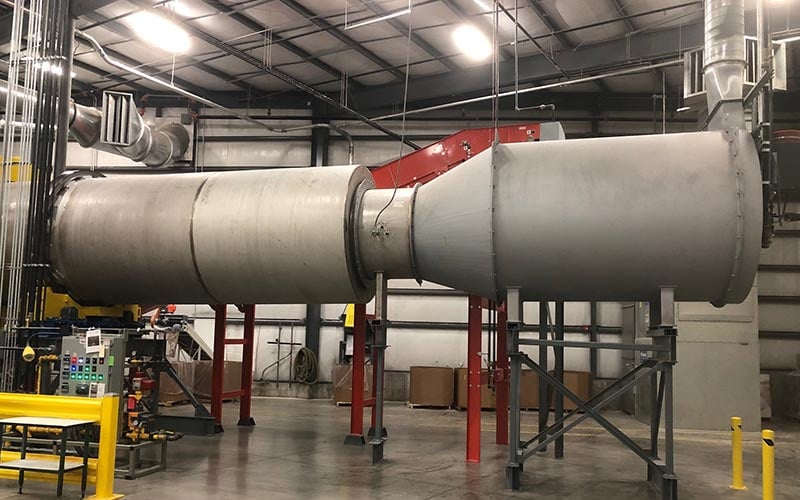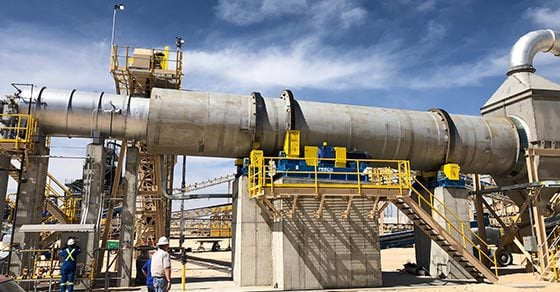Rotary dryers are one of the most commonly employed types of industrial dryers when it comes to removing moisture from bulk solids. And while most people are familiar with the difference between direct and indirect rotary dryers, few are aware that the direct category is sometimes further divided into two additional subsets: directly heated dryers and directly fired dryers.
While FEECO does not make this distinction in nomenclature, instead considering direct dryers as either with or without a combustion chamber, the use of the terms in the marketplace has caused some confusion. The following covers the differences between these two rotary dryer configurations, and why “direct-heat” dryers are preferred for high-value products.
About Direct Rotary Dryers
Although some applications require the use of an indirect rotary dryer, in most cases, the direct dryer is by far the most efficient, because of the direct contact between the material being processed and the products of combustion, making it the obvious choice in most process settings.
Rotary dryers can be configured for co-current or counter-current flow, referring to the direction of the air flow in relation to the flow of material. The selection of air flow configuration is largely based on the process and product goals, as well as the specific requirements of the material being dried.
Beyond these initial decisions, the choice of whether or not to use a combustion chamber has further effects on product quality and overall efficiency. Both configurations utilize direct contact between the products of combustion and the material being processed in order to accomplish moisture removal. One type, however, is reserved for high-value products, while the other could be damaging to such products.
Rotary Dryers With a Combustion Chamber (“Direct-Heat” Dryers)
Direct-heat rotary dryers are those in which only the heat, and not the flame from the products of combustion, are allowed to contact the material. This “direct-heat” configuration employs a combustion chamber to house the combustion reaction and keep the flame away from the material being processed.
The combustion chamber is a static furnace that is mounted to the end of the rotary dryer, either at the feed or discharge end, depending on whether the dryer is co-current or counter-current. The burner is mounted onto the combustion chamber, keeping the actual flame out of the rotary drum itself, and therefore away from the material being processed.

3D Rendering of a FEECO Combustion Chamber

Rotary Dryer with Combustion Chamber mounted to the end
Oftentimes, contact between the material being processed and the actual combustion flame is problematic, especially when it comes to high-value materials where product integrity is a concern. Contact with the flame has the potential to cause product degradation, discoloration, and often a higher amount of attrition. In some cases, it can also cause the formation of undesirable byproducts or off-gasses.
Ultimately contact with the flame would reduce product quality, making it unacceptable by market standards.
Modes of Heat Transfer in Direct-Heat Rotary Dryers
Direct-heat rotary dryers employ conduction and convection modes of heat transfer, while minimizing radiative heat transfer, which could result in product degradation.
Direct-Heat Dryer Applications
The direct-heat dryer configuration is best for materials that are sensitive to heat in some way, either physically, chemically, or in appearance. This configuration is often chosen for materials where product quality is of the utmost importance, such as when processing animal feed products, fertilizers and soil amendments, and specialty chemicals.
Potash is also often dried in this fashion, as direct contact between the flame and material would not only risk over-drying and degrading the material, but would also produce undesirable pollutants that would then require a more elaborate off-gas treatment system.
Rotary Dryers Without a Combustion Chamber (“Direct-Fired” Dryers)
In contrast, the “direct-fired” dryer encourages contact between the flame and the material being processed by not employing a combustion chamber and instead, mounting the burner directly onto the end of the rotary drum shell breeching, allowing the flame to sit inside the drum.
This direct contact with the flame makes the direct-fired configuration a slightly better option when dealing with high-moisture materials that are not sensitive to heat, as it helps to flash off a portion of the moisture content.
It may also allow for a slightly smaller air pollution control system; the radiation from the flame means less energy is required to dry the material, which equates to a lower air volume, and ultimately a smaller off-gas system, though the difference may sometimes be negligible. At the same time, however, the off-gas could be composed of increased pollutants due to the direct contact of the material with the flame, so careful consideration is necessary in selecting the appropriate exhaust gas handling system.
Modes of Heat Transfer in Direct-Fired Rotary Dryers
Direct-fired dryers are generally more efficient in terms of heat transfer, because the added contact between the flame and material allows for radiative heat transfer to occur, in addition to convective and conductive heat transfer. This improved heat transfer also often translates to higher throughput, making direct-fired dryers a good fit for high-capacity operations where product quality is not a concern.
As a way to encourage close but not direct contact between the material and flame, protective flights can be used to prevent contact without having to incorporate a combustion chamber. This reduces, but still allows some radiative heat transfer.
Direct-Fired Dryer Applications
While the direct-fired dryer offers some advantage in heat transfer efficiency, this approach must be used with caution, as it is only appropriate when product quality is not a concern, such as when drying aggregates and other similarly low-value materials.
Determining Which Rotary Dryer Configuration is Best
While the choice between a direct-heat and direct-fired dryer is dependent on material characteristics and product goals, the choice between the two types, or even how the material will respond to the drying process, is not always clear. In these cases, FEECO recommends rotary dryer testing in the FEECO Innovation Center.
Through dryer testing, producers can establish a working familiarity with their material and how it responds to the drying process. Basic and advanced process criteria are also established through testing:
- Attrition
- Particle Carryover
- Flowability
- Moisture Content
- Temperature Profiles
- Gas Sampling & Analysis
- Drum Speed
- Drum Slope
- Retention Time
- Flight Design
- And more…
In some cases, plant managers may benefit from evaluating whether their existing dryer is optimized for efficiency and product quality through a process or equipment audit. This can reveal whether the addition of a combustion chamber could benefit the process.
Conclusion
Direct rotary dryers offer extensive drying capabilities to producers working with bulk solids, with a variety of customizations and configurations available. While the choice to go with a direct rotary dryer is the most efficient, efficiency and product quality are further affected by the choice of whether or not to incorporate a combustion chamber. And although the nomenclature may vary, the results are the same; rotary dryers with a combustion chamber, or “direct-heat” dryers, are best for high-value materials where materials are heat sensitive or product integrity is critical, while “direct-fired” dryers, or those without a combustion chamber, offer a more efficient approach to processing low-value materials that are not sensitive to heat.
FEECO engineers and manufactures the world’s most reputable custom rotary dryers for nearly every industry. Our dryers are backed by decades of expertise and the opportunity to develop the drying process in our testing facility, The Innovation Center. We also offer an extensive rotary dryer parts and service program for keeping dryers running their best, whether they were built by FEECO or not. Contact us today for more information!



